I try not to play favorites when it comes to bird subjects for my photography but Short-eared Owls would have to be near the top of any such list I might make. I’ve had some luck with them here in Utah but my favorite area to photograph them is in southwest Montana. This series is from the summer of 2010 in Beaverhead County.
I spent several days watching and photographing a male owl hunt voles and then bring them in for his family (female and two chicks) at the nest at the base of a sagebrush. I thought it might be interesting for some to see a full series of shots (of those I kept) as the male approached the nest with a vole.

1/1600, f/6.3, ISO 800, 500 f/4, 1.4 tc, shot from pickup window, natural light
Like me, this male was a creature of habit. I would watch him hunting far off in the distance and when he was successful he would always repeat the same pattern. He would bring the vole in to the vicinity of the nest and then land on one of two favorite perches for a short time before delivering the vole to his family. This small sagebrush was one of those favorite perches – the other was a metal post. Here, he is in the process of landing and you can see the dark vole in his left foot.
He always carried the vole to the perch in his left foot (as I’ve documented here) and always transferred it to his beak when he took off toward the nest.
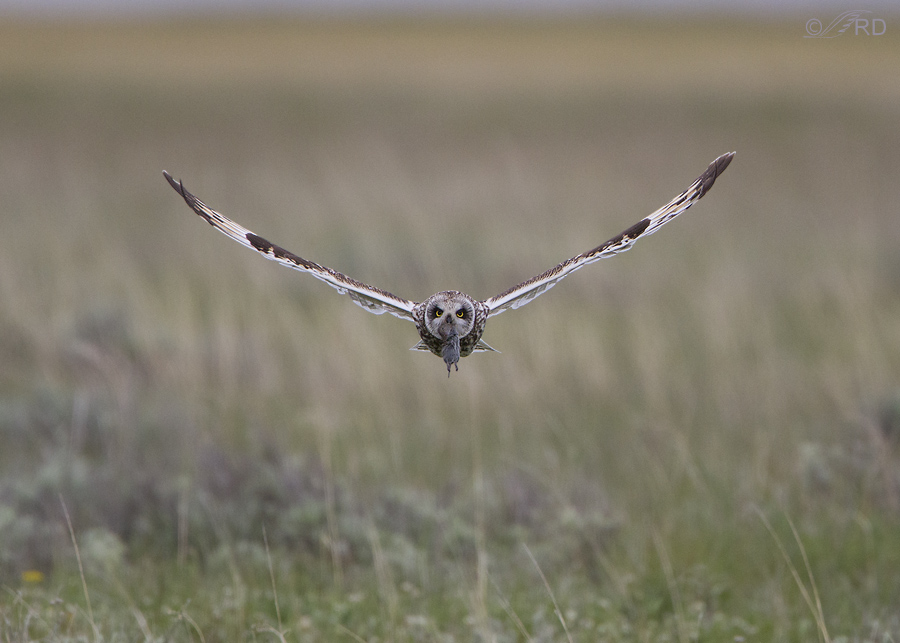
1/2000, f/5.6, ISO 800, 500 f/4, 1.4 tc, shot from pickup window, natural light
He would wait on the perch for varying amounts of time before he delivered the food (once, the female became impatient and came out and retrieved the vole from the male). When he would take off on his delivery run he would often head straight for me for the first few wingbeats before veering off toward the nest. I believe it was his way of “checking me out” on his way in.
So that the rest of this series makes visual sense I’ll set the stage. I’m in my pickup shooting out the driver’s side window. The nest is about half way between me and the sagebrush perch, but quite a bit further to my right.

1/2000, f/5.6, ISO 800, 500 f/4, 1.4 tc, shot from pickup window, natural light
After a couple of wingbeats, the owl begins to veer to my right in the direction of the nest.
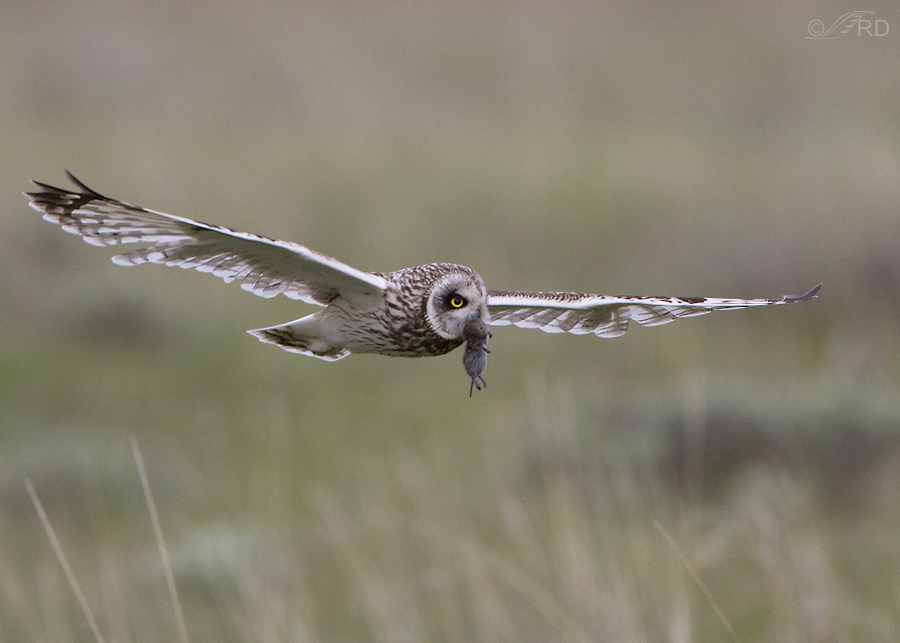
1/1600, f/5.6, ISO 800, 500 f/4, 1.4 tc, shot from pickup window, natural light
I didn’t get a lot of variation in wing position because by this time in the flight he was mostly gliding into the nest area.

1/1600, f/5.6, ISO 800, 500 f/4, 1.4 tc, shot from pickup window, natural light
Then the wings came up a little to show me more of the underside of the right wing.
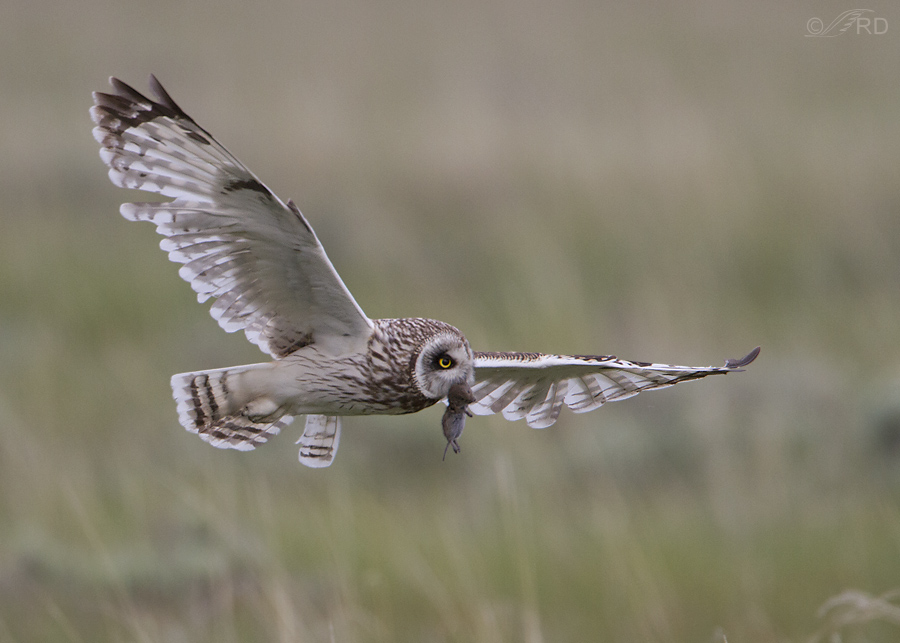
1/1600, f/5.6, ISO 800, 500 f/4, 1.4 tc, shot from pickup window, natural light
He begins to flare and turn more into the nest direction. Here we see better the molting stage of the bird, with many missing and uneven feathers.
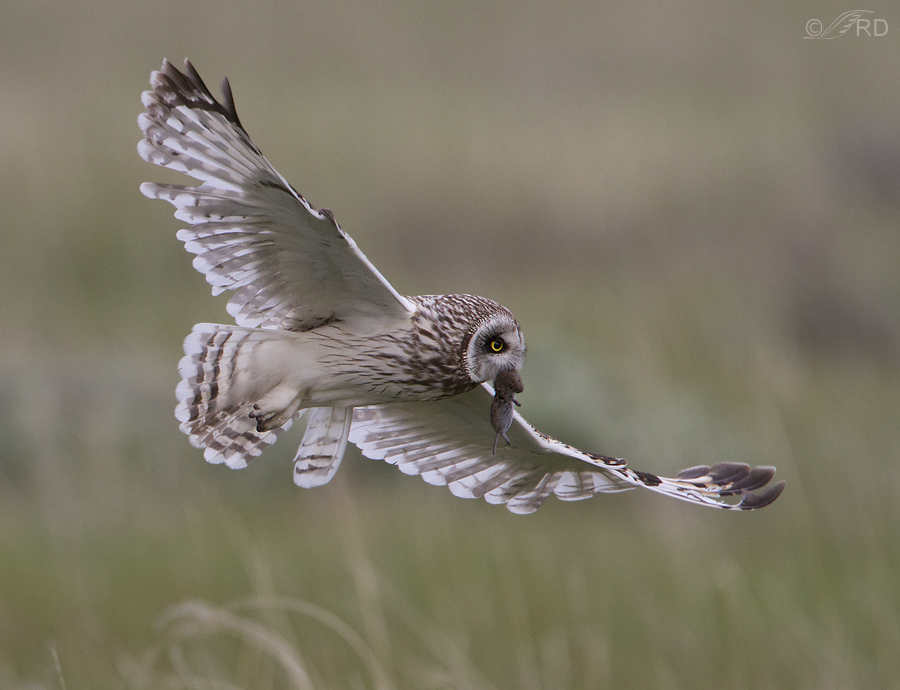
1/2000, f/5.6, ISO 800, 500 f/4, 1.4 tc, shot from pickup window, natural light
The primaries of the left wing begin to curl upwards as the owl flares and descends.
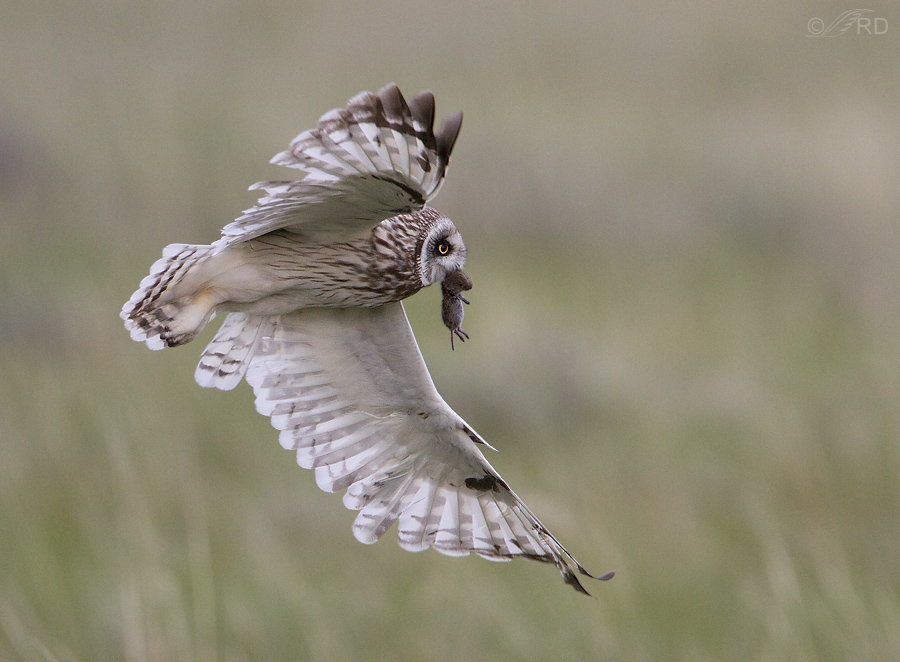
1/1600, f/5.6, ISO 800, 500 f/4, 1.4 tc, shot from pickup window, natural light, not baited
Almost there.
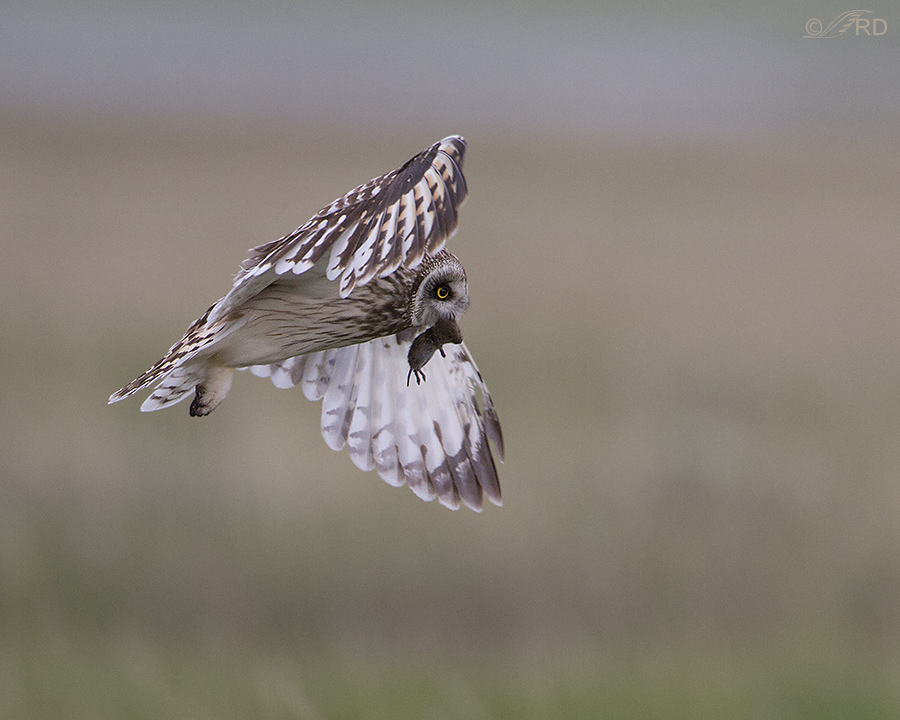
1/2000, f/5.6, ISO 800, 500 f/4, 1.4 tc, shot from pickup window
This was the last sharp shot I got as the owl dropped in front of the sagebrush and I lost focus. You can extrapolate the position of the nest from the direction and angle the bird is looking. This image has a bit of a color cast but I thought I’d include it anyway.
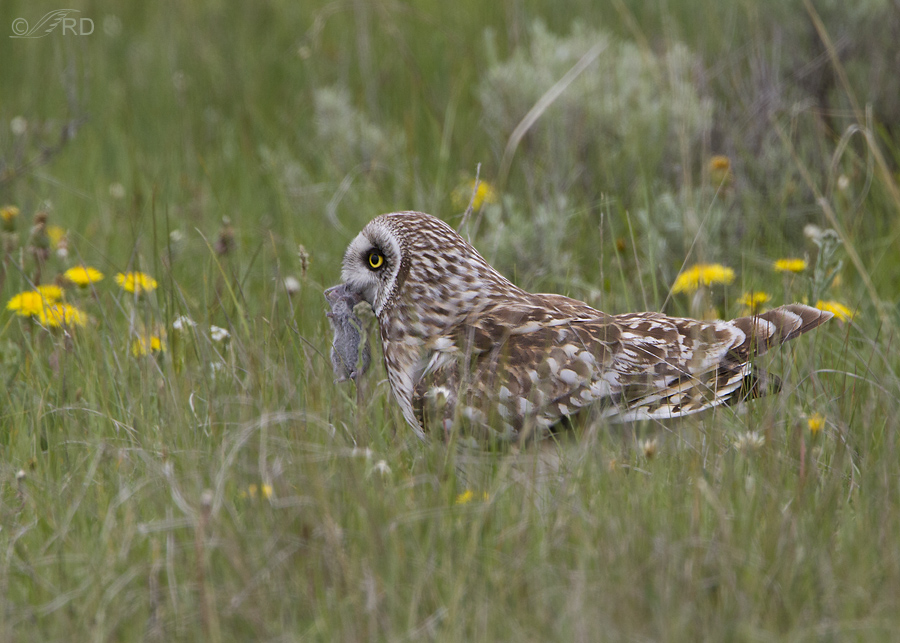
1/2000, f/6.3, ISO 800, 640 f/4, 1.4 tc, shot from pickup window, natural light
He would land in front of the sagebrush where the nest was and then cautiously approach the female in the nest. She seemed very aggressive when he brought in food.
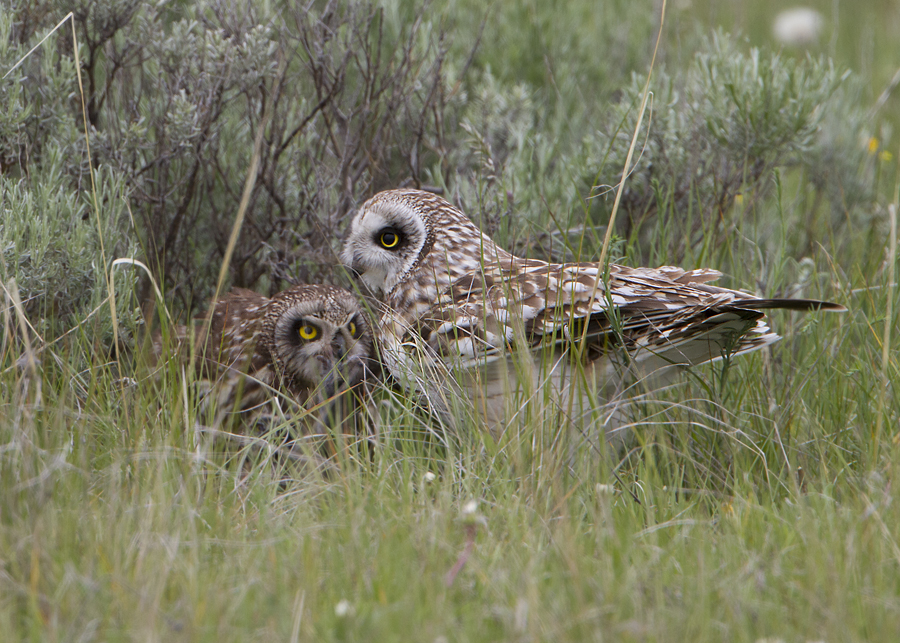
1/1600, f/6.3, ISO 640, 500 f/4, 1.4 tc, shot from pickup window, natural light
He would drop the vole in front of the female as she came out of the nest. Here she has just picked it up. The vole is hard to see but you can make out its foot just to the viewers left of her beak. She seemed to glare at him, almost daring him to make a move for the vole. He would always act very timid, then back away from the nest and fly off on another hunting foray.
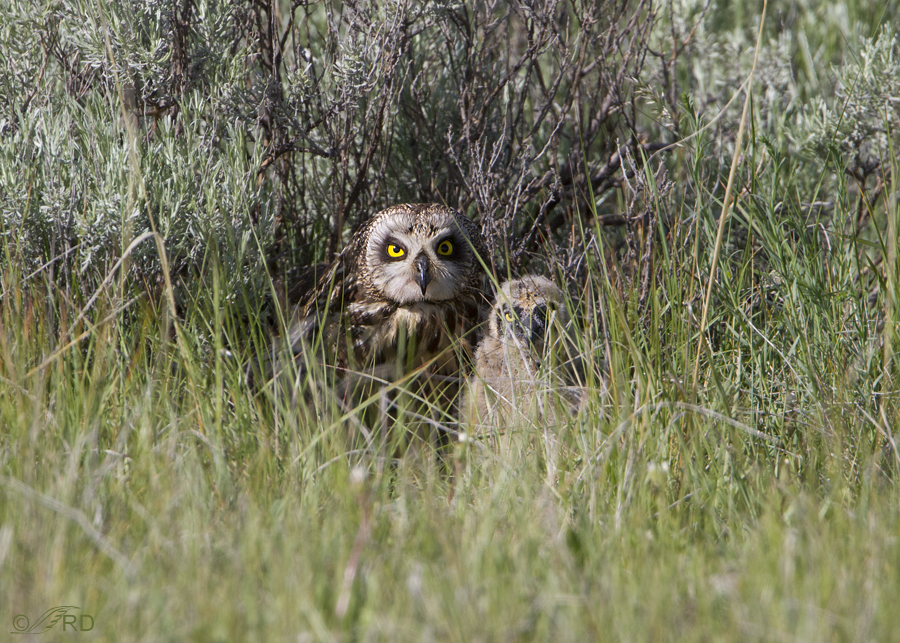
1/2500, f/6.3, ISO 500, 500 f/4, 1.4 tc, shot from pickup window, natural light
I only saw the chicks once, when the female brought them out from the nest a little to enjoy the warming sun on a cold morning. Only one is visible here.
A few notes about this series:
- The last 3 images were taken in the two days after the previous shots in the series. I’ve posted similar images to those three before.
- As alway, these shots were not baited or set up
- I was extremely careful not to disturb these birds. All shots were taken from inside my pickup while parked on a road. The birds were accustomed to the traffic on the road and not disturbed by it. I never once got out of my truck (or even opened a door) while I was photographing them. The only times I ever saw any sign of disturbance was when another owl would fly into the territory of this male.
- All of the images in the flight series were taken in low light (cloudy day).
Ron


Ron, wonderful shots. I could scan through your images for hours. I appreciate your ability and patience to “get the angles” and frame these pictures. For all practical purposes, I’ve just started shooting raptors. I wish I had the experience to capture images such as yours…probably wouldn’t hurt to have some of your equipment too. Keep shooting and I’ll keep looking. Take care.
Thank you, Tracy. Yes, the “equpment” is a significant part of the equation, but time spent in the field – just working at it, is at least as important, IMO. I wish you luck with your raptor quest.
Hi Ron
These owls are my favourite species and the images are of the highest order. Such clarity – wonderful.
Thanks very much, Christian.
Great shots Ron! I’ve had experiences similar to that male!! Some days you just can’t seem to do anything right.
So have I, Wayne. So have I…
Ron, you never fail to amaze me, getting these incredible in-flight shots. Absolutely awesome.
Thanks a lot, Bob. Coming from another bird photographer, your comment meant a lot to me.
I am a little (a lot) bird obsessed. However, owls and raptors are well up on my favourites list, probably because I rarely see them. You so often feed my favouritism, and I loved this sequence – thank you. I was interested in you noting that the owl was ‘left footed’. We have noticed similar preferences in our cats (yes I know loving cats and birds seems contradictory). I think we have only once had a cat that was ambi-pawed.
Anthromorphism or not that female did seem to glare for the camera. And the chick? Simultaneously ugly and enchanting as birds so often are until they first fledge into their adult plumage. Thank you, yet again.
Nothing wrong with bird obsession, Elephant’s Child – it keeps us sane (or at least it works for you…).
I enjoyed your comment. All of it.
WOW… These are just amazing. Absolutely perfect, and as another says — very educational, as always!
Fascinating behavior described and just incredible images, Ron. Thank you for this.
Thanks very much, Melissa.
You could make a great educational picture book for older elementary students out of this! The shots are fantastic! and the description is riveting. Once again, thanks for sharing.
Thank you for the encouragement, Tana. Much appreciated, as always!
In wildlife rehab, we, too, often try to figure out if the birds are right or left-footed .. it can make a difference if, say, there’s been an injury to a leg or foot. But it’s very difficult to observe them, without them seeing you and being disturbed; plus they are typically not carrying food. Unfortunately, they have to be fairly comfortable before they will even tear into food in our presence – we could then see which foot, though it’s often both, is used more to hold food down. I would wonder if falconers watch their birds that closely, but i KNOW the last thing they want their birds TO do is carry!
“Handedness” in birds fascinates me, Louise.
Thanks, Teri and Susan.
Very nice! Thank you…
Great photos! Thanks!